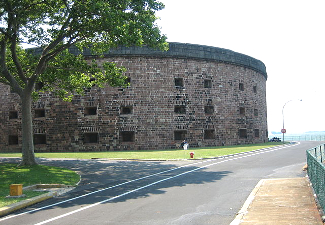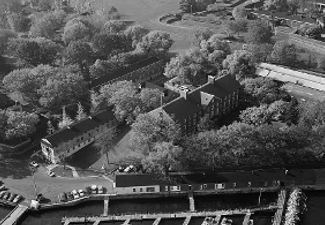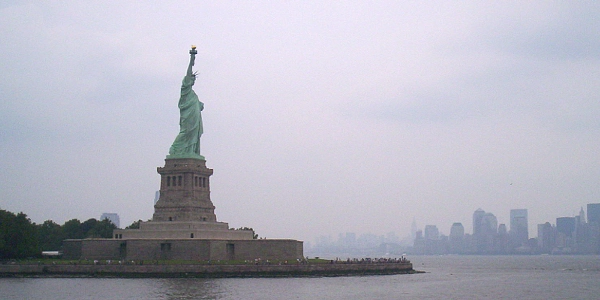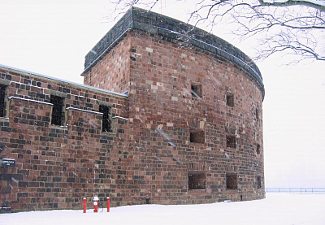
Above photo: Castle Williams in winter. Courtesy National Park Service. Right: Lithograph of New York from Governors Island, 1821-1825, Henry I. Megarey. Courtesy Library of Congress.

Governors Island National Monument
Not unknown, as the half million visitors suggest, but almost unknown outside the New York area, at least when compared to its magnificent cousins, Ellis Island, the Statue of Liberty, and Castle Clinton. It was an island used to protect the harbor from the British during the American Revolution, but that didn't work, it was an island used to protect Manhattan during the War of 1812 after better forts built, which it did.. So when you step off the ferry (a less expensive one than that to the more famous islands), you'll see Castle Williams and Fort Jay on the National Monument side. And there's more on the one hundred and fifty acres outside the Monument, too, to see and do as well. Oh, and for those coming to visit. It's a summer place, at least for now, open from May through September, so plan accordingly.
Sponsor this page for $100 per year. Your banner or text ad can fill the space above.
Click here to Sponsor the page and how to reserve your ad.

Since the American Revolution until just prior to the turn of the 21st century, Governors Island has played a role in the defense of New York City. It was captured from Continental forces by the British after the Battle of Brooklyn (Battle of Long Island) and served as a defense for the enemy for the remainder of that war for Independence. During the War of 1812, its strong new forts would force the British to think of attacking elsewhere, to the chagrin of D.C. residents. During the War Between the States, Confederate prisoners were housed within its walls. World War II saw Governors Island as the base for the 1st Army Corps. Today that history is shown to visitors of the new National Monument (2001-3) with two restored forts, plus the remaining grounds of the monument and island. Only eight hundred yards from Manhattan and even closer to Brooklyn, it's history that should be visited, just as that of those better known cousins to the west and north.
Photo above: Entrance to Fort Jay, 2016. Courtesy National Park Service/Michael B. Shaver. Photo Middle: Co. E., 12th Infantry on parade, 1908. Courtesy Library of Congress. Photo Bottom: Lithograph of New York City from above with Governors Island on the right, 1888, L.W. Schmidt. Courtesy Library of Congress.
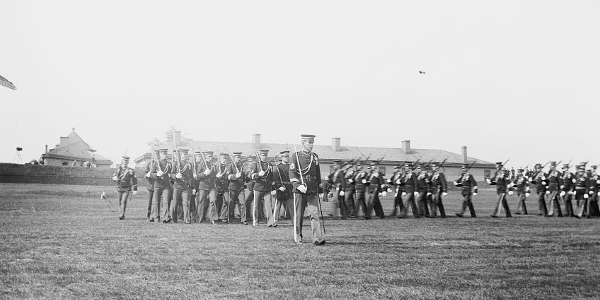
Governors Island Then
Castle Williams - Completed in 1811, the round fortification was the preeminent style fort from that year through the next fifty in coastal defenses. It complemented two other forts on Governors Island; Fort Jay and the South Battery. The harbor was defended by Governors Island, Castle Clinton on Manhattan, Fort Gibson on Oyster Island (Ellis Island today), and Fort Wood, which is now the base for the Statue of Liberty. During the War of 1812, the British considered the defenses provided by these forts as too strong to attack, instead choosing Maryland and the burning of Washington. After 1830, Castle Williams was no longer useful as a fort, but served as a garrison for troops, and later a prison.
Fort Jay - Built after the American Revolution, which saw earthworks on the island controlled at first by Continental Army troops before the British took over, Fort Jay was built during the last years of the 18th century. It was named Fort Jay after John Jay, the Governor of New York, in 1798, and was reconstructed by the year 1809 to serve in the defenses of the City of New York during the War of 1812. The fort was used by the Coast Guard from 1966 to 1997.

Governors Island Now
Part of the reason more tourists don't know of Governors Island National Monument compared to its harbor cousins is the newness of the monumnet. It was established in 2001 and 2003 by the presidential proclamations of President Clinton. Today, Castle Williams and Fort Jay, a pentagon shaped star fort, have been restored and are available to visit by tour or on your own.
The remaining acreage is run by the Trust for Governors Island. There are fifty-two historic buildings on the trust land. BTW. The island was not always this large. In 1912, one hundred and three acres were added with ground from subway construction.
T-Shirts and Souvenirs

Governors Island National Park T-Shirts and other history souvenirs from the official merchandise of America's Best History.

Governors Island
Things You Should Not Miss
1. Take a guided tour of Fort Jay, Castle Williams, or the island itself. There's no better way to see the history of Governors Island than to have the experts point it out and tell you. There are a variety of options in the summer, including roof top walks, porch talks, and long form around the island hikes.
2. If you're there on one of the Artillery Demonstration weekends, take a listen, and imagine what that would have been like, either during the Revolution (no these forts weren't there, but there were earthen forts and troops) or if the British had come to New York during the War of 1812 and they needed to be used in defense of the city.
3. Don't forget to enjoy the ferry ride. One of the joys of going to island forts in the National Park Service, is you get to take a boat ride. Whether that be to the Statue of Liberty, Ellis Island, or Fort Sumter in Charleston, it's a treat. And this one's cheap, too.
Photo above: Castle Williams in 1896. Courtesy National Park Service.
Visitor FAQ
Governors Island Links
Governors Island National Monument
Official Guide New York City
New York Harbor Parks

